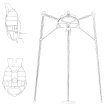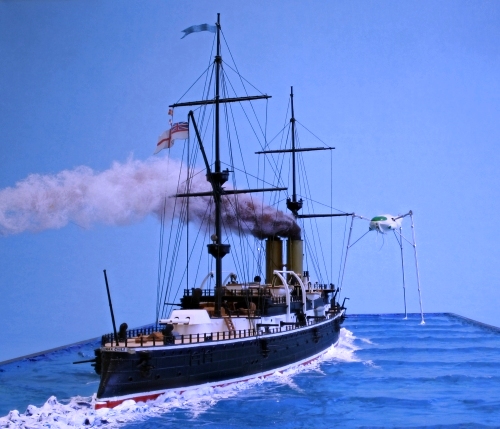

| H.G. Well's novel, The War of the Worlds, is a classic of science fiction literature. It's enduring story has been translated into many media. Orson Welles made history of a sort when his "Mercury Theater of the Air" radio production of The War of the Worlds caused panic among some of his listeners. In the early '50s, George Pal's movie version of The War of the Worlds updated it to that time and moved it to America, but kept the essential story of the human race helpless before a seemingly invincible foe. In more recent years, The War of the Worlds was transformed into television and comic book series. As a scale modeler, I saw the potential for interesting modeling projects based on The War of the Worlds. I had already built a model of a Martian warmachine as it is depicted in the Classics Illustrated comic book when a rock-opera version of the story gave me the idea for a more ambitious model project. |
| Perhaps one of the most unusual but successful translations of Wells' story was by Jeff Wayne, who's rock-opera musical version of The War of the Worlds featured a talented cast headed by Sir Richard Burton and some really first rate music. Jeff Wayne's album included a booklet the same dimensions as a vinyl LP cover with the text of the song lyrics and specially commissioned paintings that illustrated the scenes described in the lyrics. |  |
| One of those paintings depicted the battle between the Martian war machines and a British warship, H.M.S. Thunder Child. Since my modeling interests include both period ship models and science fiction models, this combination of the two was irresistable. I could see the diorama clearly in my mind. It wasn't exactly like the painting, since that had some problems with the releative sizes of the two elements, but the composition was much the same. |  |
| Something that made a diorama based on the artwork in the booklet especially appealing was the publication of a "poster magazine" in conjunction with the release of the album. It was a British publication, but was available in the U.S. through several sources. I believe I bought my copy from Starlog. What made the magazine a "must have" for me was that it was advertised as containing "blueprints" of the Martian war machines. And, in deed, it does. They are even pretty decent three view drawings, though I redrew them to make minor improvements and to have a set of plans from which I could build a model. It is hard to explain why having "official blueprints" made such a difference to me, but so much of my science fiction modeling was of subjects that were unrecognizable to anyone but myself, it was nice to be able to pull out the plans and "prove" that the design was "real." It wasn't particularly logical and, these days, I take pride in the uniqueness of my models but, at that time, having published plans was important to me. |  |
| With plans for the Martian war machines in hand, I had to decide how to build Thunder Child. I started researching turn-of-the-century Royal Navy ships, a subject I really didn't know much about. I had purchased a book of marine illustrations by Chris Mayger because I was fond of his work on the covers of the Richard Bolitho series by Alexander Kent. It included this picture, from which I incorporated several details. |  |
| Another useful reference was a picture of a large, Royal Navy warship on the cover of a facsimile edition of Jane's All The World's Fighting Ships, 1898. I used many elements from it in the construction of the model. |  |

All text, illustrations, photographs and design are © 2000-2013 Dan Thompson, except where otherwise noted.